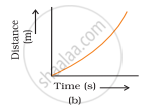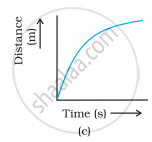Advertisements
Advertisements
Question
Which of the following figures (Fig. 8.3) represents uniform motion of a moving object correctly?
Options
Solution

In uniform motion, object covers equal distances in equal intervals of time. Therefore, the distance-time graph must be a straight line inclined to the time axis. Hence, graph (a) is correct.
APPEARS IN
RELATED QUESTIONS
Joseph jogs from one end A to the other end B of a straight 300 m road in 2 minutes 30 seconds and then turns around and jogs 100 m back to point C in another 1 minute. What are Joseph’s average speeds and velocities in jogging?
- from A to B and
- from A to C?
Name the physical quantity obtained by dividing ‘Distance travelled’ by ‘Time taken’ to travel that distance.
Write the formula for acceleration. Give the meaning of each symbol which occurs in it.
A train travels the first 15 km at a uniform speed of 30 km/h; the next 75 km at a uniform speed of 50 km/h; and the last 10 km at a uniform speed of 20 km/h. Calculate the average speed for the entire train journey.
A car is moving along a straight road at a steady speed. It travels 150 m in 5 seconds:
How long does it take to travel 240 m ?
The speed of a moving object is determined to be 0.06 m/s. This speed is equal to :
Which of the following can sometimes be 'zero' for a moving body?
(i) average velocity
(ii) distance travelled
(iii) average speed
(iv) displacement
Which of the quantity-velocity or acceleration-determines the direction of motion?
Arrange the following speeds in increasing order.
10 m s-1, 1 km min-1 and 18 km h-1.
Draw the shape of the velocity-time graph for a body moving with (a) Uniform velocity and (b) Uniform acceleration.



